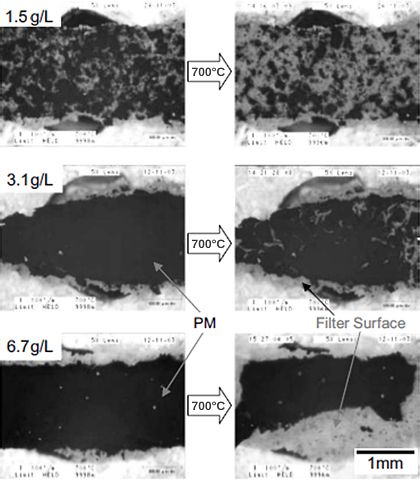To check the DPF soot level, use a scan tool that provides live data to view the soot content in your vehicle’s DPF. It is best to consult a professional or refer to the vehicle’s manufacturer for specific instructions on how to perform this task.
Understanding Dpf Soot Level
To check the DPF soot level, take your car on a constant-speed journey so that the excess soot can be burned away. If the warning light is red, it might indicate a more serious problem or DPF damage, so it’s best to seek professional help.
|
Understanding DPF Soot Level
The DPF (Diesel Particulate Filter) is an essential component of modern diesel engines that helps reduce emissions. The soot level in the DPF is a crucial indicator of its health and performance. A normal DPF soot level refers to the amount of accumulated soot that is considered acceptable and within the operating range of the filter. The level of soot in the DPF is measured using a technology called differential pressure (∆P). This method estimates the mass of soot in the filter based on the difference in pressure across the filter. If the soot level in the DPF becomes too high, it can lead to various issues, including reduced engine performance, decreased fuel economy, and even engine damage. It is important to regularly check the DPF soot level to ensure proper functioning of the filter. If you notice symptoms such as loss of power, excessive exhaust fumes, or poor acceleration, it could indicate a blocked or clogged DPF. In such cases, it is recommended to consult a professional for further diagnosis and maintenance. |

Credit: dieselnet.com
Checking And Monitoring Dpf Soot Level
Checking and monitoring the DPF soot level in your vehicle is crucial for maintaining its performance and efficiency. DPF (Diesel Particulate Filter) is designed to trap and remove harmful particulate matter from the exhaust gases of diesel engines. However, over time, the DPF can become clogged with soot, affecting the engine’s performance and fuel economy.
There are several symptoms that indicate a blocked DPF. These include loss of power, reduced fuel economy, excessive exhaust fumes, a hot and strong smell from the engine, poor acceleration, and the start/stop function may stop working.
To check the DPF soot level, you can use diagnostic tools that provide live data from the DPF. These tools can display the soot percentage and enable you to perform a regeneration if necessary. Additionally, you can take your vehicle on a journey at a constant speed to allow the DPF to turn excess soot into ash.
By regularly checking and monitoring the DPF soot level, you can ensure that your vehicle remains in optimal condition and avoid potential issues caused by a blocked DPF.
Managing Dpf Soot Level
Resetting soot levels is an essential part of maintaining your diesel particulate filter (DPF). If your vehicle is equipped with a DPF, it is crucial to monitor and manage the soot level to prevent excessive buildup. One way to reset the soot levels is by using cleaning additives specifically designed for DPFs. These additives help break down and remove accumulated soot, improving the overall function of the filter. Regularly using these additives can help maintain optimal performance and prevent potential issues.
Preventing excessive soot buildup is another important aspect of managing DPF soot levels. Keeping up with regular maintenance, such as frequent oil changes and proper fuel quality, can reduce the amount of soot produced by the engine. Additionally, avoiding short trips and ensuring the vehicle reaches operating temperature can also minimize soot accumulation. Regularly monitoring your DPF soot level and taking proactive measures can extend the lifespan of your DPF and ensure optimal engine performance.

Credit: forums.mbclub.co.uk

Credit: www.facebook.com
Frequently Asked Questions On How To Check Dpf Soot Level
What Is A Normal Dpf Soot Level?
A normal DPF soot level is measured using the differential pressure (∆P) sensor. It estimates the amount of soot mass in the DPF. If the DPF becomes clogged or if there is a fault in the system, an orange dashboard light may appear.
Symptoms of a blocked DPF include loss of power, reduced fuel economy, excessive exhaust fumes, and poor acceleration.
How Is Dpf Soot Measured?
DPF soot is measured using the differential pressure (ΔP) technology, which is the most widely used method. This sensor calculates the soot mass in the DPF. Symptoms of a blocked DPF include loss of power, reduced fuel economy, excessive exhaust fumes, and poor acceleration.
Driving at a constant speed can help the DPF convert excess soot to ash. If the warning light is red, it may indicate a more serious problem, and professional assistance should be sought.
How Do I Know My Dpf Is Blocked?
To determine if your DPF (Diesel Particulate Filter) is blocked, watch out for these common symptoms: loss of power, reduced fuel economy, excessive exhaust fumes, a hot and strong smell from the engine, poor acceleration, and the Start/Stop feature may stop working.
If you notice these signs, it is advisable to consult a professional for further assistance.
What Is Too High For Dpf Soot Level?
If the DPF (diesel particulate filter) becomes clogged with soot or a system fault occurs, an orange light will typically appear on the dashboard. This warning light varies slightly by manufacturer, so refer to your vehicle’s handbook for more specific information.
Conclusion
To ensure your vehicle’s optimum performance, it is crucial to regularly check the DPF soot level. By monitoring this level, you can prevent potential issues such as loss of power and reduced fuel economy. The most widely used method to measure DPF soot mass is through the measurement of differential pressure.
If you notice any symptoms of a blocked DPF, such as excessive exhaust fumes or poor acceleration, it is essential to consult a professional for further diagnosis and maintenance. By staying proactive and monitoring your DPF soot level, you can keep your vehicle running smoothly and efficiently.





